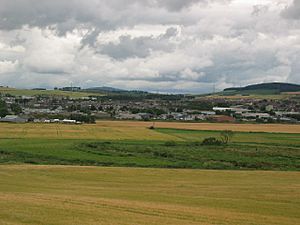Battle of Inverurie (1745) facts for kids
Quick facts for kids Battle of Inverurie |
|||||||
|---|---|---|---|---|---|---|---|
| Part of the Jacobite rising of 1745 | |||||||
 Present-day view of the battlefield |
|||||||
|
|||||||
| Belligerents | |||||||
| Commanders and leaders | |||||||
| Strength | |||||||
| 900 | 500 | ||||||
| Casualties and losses | |||||||
| 14-60 killed 20 wounded |
7-"many" killed 22 wounded 50 captured |
||||||
The Battle of Inverurie was a fight that happened on December 23, 1745. It took place in Inverurie, Aberdeenshire, Scotland. This battle was part of the Jacobite rising of 1745.
The Jacobite Rising was a conflict where supporters of the exiled Stuart royal family, called Jacobites, tried to put their leader, Charles Edward Stuart (also known as Bonnie Prince Charlie), back on the throne of Great Britain.
Contents
Why the Battle Happened
Jacobite Plans in Scotland
After the Jacobites took Edinburgh in the autumn of 1745, Lord Lewis Gordon was put in charge of Aberdeenshire. His job was to gather more men for the Jacobite army in north-eastern Scotland.
Lord Gordon managed to create a large group of soldiers. Some were volunteers, and others were "pressed" into service, meaning they were forced to join. His group had three main parts, called battalions.
These battalions included:
- The "Aberdeen" battalion: mostly volunteers from the city of Aberdeen.
- The "Strathbogie" battalion: made up of men who were forced to join.
- The "Mar" battalion: mainly Highlanders from areas like Braemar.
Lord Gordon also started collecting taxes, called the "cess," to get more money for the Jacobite cause.
Government Response
In December, the government's main commander in the north, John Campbell, 4th Earl of Loudoun, sent his own forces. He sent Norman MacLeod of MacLeod from Inverness with 500 soldiers. Their mission was to stop Lord Gordon.
MacLeod was supposed to meet up with more government troops along the way. These included 200 men led by George Munro, 1st of Culcairn and another 500 men from the Laird of Grant.
Lord Gordon heard about the government forces and moved his men back to Aberdeen. There, he received more soldiers from other areas like Forfarshire and Kincardineshire. He also got a small group of French and Scottish regular soldiers. These soldiers had recently arrived in Montrose from France.
How the Battle Unfolded
Moving Towards Inverurie
The Laird of Grant decided not to join the government forces and went home. Culcairn's men stayed at Oldmeldrum. However, MacLeod continued his advance and took control of the town of Inverurie. This town was about 16 miles north-west of Aberdeen.
When Lord Gordon learned that MacLeod was in Inverurie, he decided to attack first. He left Aberdeen on December 23 with about 1,100 men. He also brought five cannons that had been taken from a ship in the harbor.
Lord Gordon and another leader, Avochie, each led a column of Jacobite troops. But it seems that a French officer named Major Lancelot Cuthbert was actually in charge of the attack. He was a regular soldier in the French army.
The Jacobite Attack
The Jacobites crossed the Bridge of Don and marched along the left side of the River Don. Lord Gordon sent a smaller group of 300 men, including the French soldiers, on a different road. This was a trick to make MacLeod think the main attack would come from that direction.
Around four o'clock in the afternoon, the Irish soldiers, who had marched along the right side of the River Don, waded across the river. They attacked MacLeod's troops on the south-western side of Inverurie. About 60 of MacLeod's men fought them at the river crossing. This is where the Jacobites lost most of their soldiers, including 11 French regulars.
Lord Gordon then crossed the River Ury and attacked the town near the church. This attack surprised the government defenders. They fired several shots as the main Jacobite army crossed the river.
Retreat of Government Troops
The MacLeod soldiers then retreated down the main street of Inverurie. They fired a few more shots as they went. They could not hold their positions and were forced to move back northwards. By the end of the evening, they had retreated all the way to Elgin.
Casualties and Losses
According to historical records, the government troops lost seven men who died. Fifteen were wounded, and 59 were taken prisoner. Other sources suggest that the government had even more casualties.
A Jacobite soldier who was at the battle said that 14 of their men died. A government officer thought that the Jacobites had lost between 30 and 40 men.
A document from that time, called the Culloden Papers, praised MacLeod's actions. It said that his brave behavior and the stand his small army made against 900 men was "much to his honour."
What Happened Next
About fifty of MacLeod's men were captured by the Jacobites. This included several officers and important people like John Chalmers, a former professor. Donald Ban MacCrimmon, a famous piper, was also taken prisoner.
The rest of MacLeod's soldiers, including MacLeod himself, managed to escape and returned to their own areas. The Battle of Inverurie was a victory for the Jacobites.

